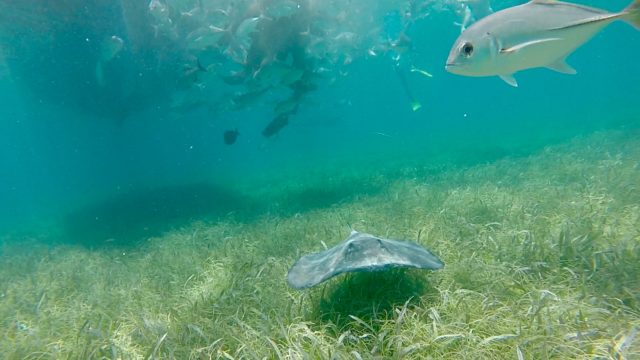11 May 2017
Shark Ray Alley, to visit or not to visit… For those of you unfamiliar with this particular snorkel destination located between Caye Caulker and Ambergris Caye along Belize’s barrier reef, it’s essentially a frenzy of nurse sharks and sting rays in crystal clear Caribbean waters. The part of me that would do anything for an opportunity to be close to elasmobranchs in the wild was dying to go. However, the marine conservationist in me was wary of supporting this particular marine attraction since I knew that it only existed because tour operators baited the water to attract the fish. Let me just give you a rundown of the argument that was running through my mind:
- I am not in support of baiting the water to attract marine life, particularly apex predators, as it throws off their natural ecology.
- However, I am also strongly for shark preservation and conservation, and a big obstacle to that is the negative perception of sharks many people still hold.
- One of the best ways to fight these negative stereotypes is for people to see sharks in their natural habitats first hand, and see just how incredible and non-threatening they can be.
- Shark Ray Alley provides just such an opportunity. An opportunity many people might not otherwise have.
- But it is only possible because they bait the water…
- Could the benefit of the educational opportunities outweigh the potentially negative impact to the local elasmobranch ecology in this instance?
Hence my dilemma.
In the end, I decided to see how the experience was run and managed for myself. So I did some research and signed up to go out with a company known to have a good track record for respectful environmental practices: Raggamuffin Tours.
The day began at 10:00am with a fitting for snorkel gear at their shop, located at the north end of Caye Caulker, followed by a brief meeting before our group of 15 boarded the little 40ft sailboat. The day could not have been finer. The sun was out in full force, bringing out the most brilliant array of turquoise hues in the water, and the wind was just strong enough to carry us easily along without the aid of a motor. I sat perched on the bow, my feet dangling over the side, every now and then getting drenched by an errant wave. It was bliss. In the hour it took to reach our first destination I got to know my neighbors on the bow, fellow travelers from Australia who’d just finished up a work season in Whistler and were reveling in the opportunity to see sunlight once again. The crew brought around freshly cut watermelon for us to munch on, while frigatebirds swooped down around the crew members preparing sardines for the days adventure.
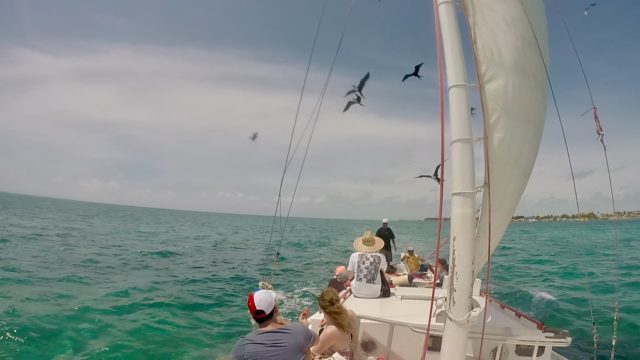
In what seemed like no time, we arrived at our first destination, a site known to be frequented by a large resident loggerhead sea turtle. According to our guides, a local fisherman uses this site to clean out his conch catch each day (as evident from the virtual conch graveyard that spanned the area), and over time this had attracted the loggerhead turtle, and some other hungry critters. We jumped into the water a short distance from the fisherman himself, and our guide led us over to the site. Sure enough, there was the loggerhead turtle, beautiful and sizable, bobbing curiously around the small fishing vessel, but it wasn’t alone. At least a dozen southern stingrays were patrolling the sea floor (which was only about five feet below the floating snorkelers), and a large congregation of hungry fish were darting within the shadow of the boat. I felt like a kid in a candy shop. I kept care to stay floating at the surface, fins high so as not to step on the rays just below me and arms crossed so I wouldn’t be tempted to reach out and touch the rays or turtle that kept curiously approaching me. As brilliant as the more charismatic megafauna were, I was just as mesmerized with the colorful and bizarre looking trunk and cow fish darting around me. The guide that accompanied us did a good job of pointing out all the different species and answering questions about their physiology and ecology. He also wisely put himself between the snorkelers and the boat, so that we all remained a respectful distance from the frenzy of activity. But that didn’t stop the more curious individuals from approaching snorkelers of their own accord.
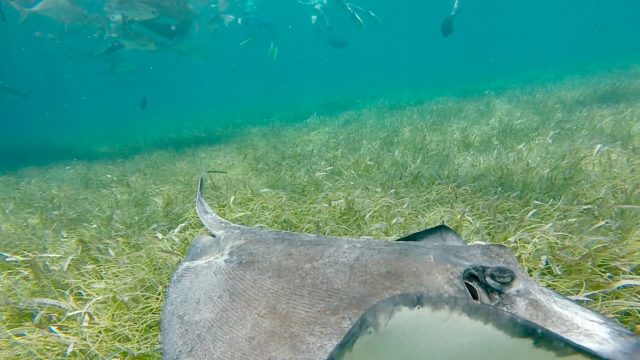
[To see an up close encounter with these rays check out my video here!]
All too soon, we were shepherded back to the sailboat, and cruising towards our next destination: the Aquarium, better known as Shark Ray Alley. Before we entered the water here we were briefed on what to do, and what not to do, when in the water. We were to remain at least 10ft from the feeding area (aka the frenzy of sharks and rays), we were not to touch any of the animals, and we would not be feeding any of the animals ourselves, the guides alone would do that and they would be doing it from the boat. So with much excitement, or nerves in the case of some, we jumped into the water and watched as elasmobranchs came from every direction, attracted by the smell of the sardines.
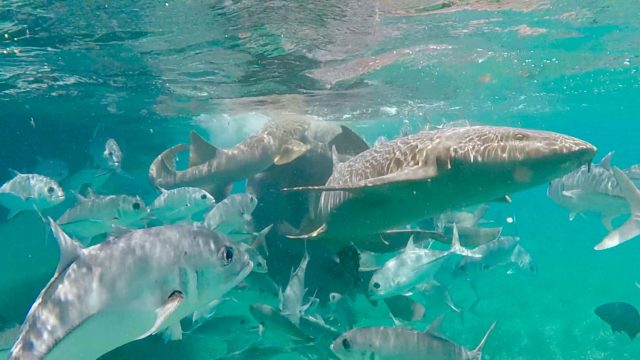
Again, I was in heaven. Getting to watch these strong and lithe fish feed up close, and patrol the sea floor when they decided they’d had enough, was a pretty incredible experience. Seeing the excitement on the faces of the other snorkelers was equally exciting, especially those that had entered the water with nervous anticipation. Then, as quickly as they had come, they were gone. They were there for the fish and the fish only, and as soon as the food ran out, they lost all interest and went on their way.
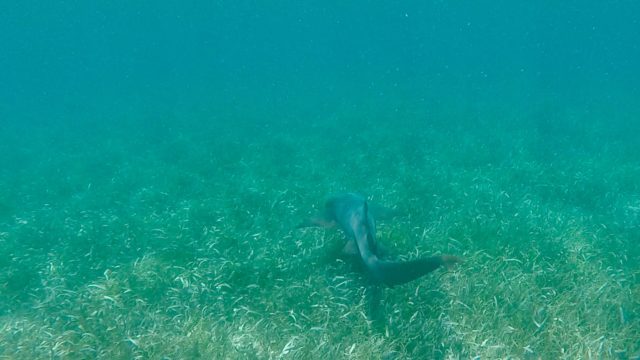
We stayed anchored in the Aquarium while lunch was dished up, generous portions of rice, salad, and your choice of seafood curry or jerk chicken. While I ate, I watched as the marine Park Rangers patrolled the site in their boat, monitoring the activity of the tours. We saw them again at the next site, Hol Chan, another popular snorkel destination within the marine reserve. Hol chan means “small channel” in Mayan; it is a naturally formed channel that cuts through the reef, making for an awesome snorkel site since the deep water attracts a different variety of marine species. To ensure minimal disruption to the reef, snorkelers are required to stay with their guides at this location, a regulation we were told the rangers would strictly enforce. I didn’t mind this too much as our guide allowed us time to explore different areas of the reef without feeling too rushed. He also tried to point out as many different species to us as he could, diving down to point it out before returning to the surface to give us the common name. I’ll admit I was a little too distracted free diving to listen to most of what he was saying. I was more interested in getting closer looks at the barracuda and eagle ray that were gliding below me. Before heading back to the boat, our guide showed us a swim through 15ft under at the edge of the channel that he invited us to dive through if we liked. I happily obliged, and was treated to a close up view of a large school of snappers hiding beneath the overhang as I passed through.
The rest of the day was lazy but enjoyable. We stopped at one more snorkel site, a coral garden that was beautiful, but rather unremarkable, before sailing the the long way back to Caye Caulker. Fresh ceviche and rum punch were passed around by the crew, and reggae music pumped through the stereos. We were treated to a surprise dolphin show when a local bottlenose decided to play off the stern of a catamaran sailing beside us, and a brief but awesome glimpse of a large eagle ray leaping from the turquoise water. The captain took us in along the west side of the Caye, offering a different view of the island than we’d seen that morning, and stopped at one final site before taking us back to the dock.
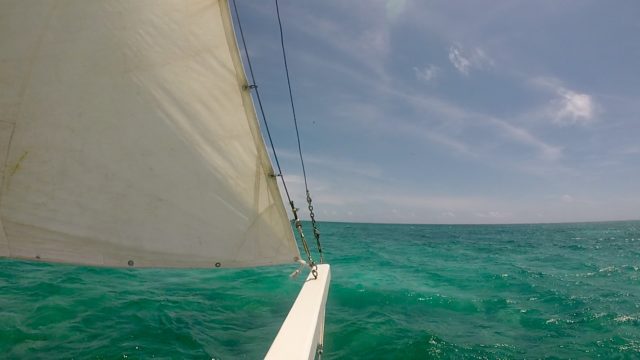
The site, located just offshore of the north point of Caye Caulker, was home to a school of giant tarpon. If you’ve never seen a tarpon before, think of a cross between coy fish and mackerel, with long, thin, powerful bodies, massive round scales, and upward facing mouths that make it look like they are perpetually grumpy. At first glance they gave the impression of being rather slow and lumbering, content to just float. So when the crew offered us sardines to feed them, I was expecting it to be much like feeding coy in a coy pond. I was wrong. I was very, very wrong. The first passenger to dangle a sardine above the water was in for a wicked surprise when a four foot long fish leapt out of the water at speeds I wouldn’t have thought possible, to snatch it from his fingers. He didn’t quite get his fingers out of the way in time, and the tarpon didn’t seem inclined to discern between fish and fingers. The man yelped in shock, and whipped his hand back. He was unscathed, but I think it took a while for his heartbeat to return to a normal rhythm.
“Who’s next?” the crew asked, offering sardines to the remainder of the passengers. I was torn between fear and excitement, but grabbed a sardine none-the-less and screamed as a tarpon I hadn’t seen lurking under the boat snatched it away before I even knew what happened.
I started the day unsure of what to expect or how to feel about the whole excursion, but I left with a smile on my face and a positive perception of the Shark Ray Alley experience. While tour operators do bait the water, the whole operation is closely monitored by the Parks Service, and the guides were respectful and conscientious of any impact to the wildlife throughout the tour. I don’t know that this can be said for all tour companies leaving Caye Caulker, in fact, I’m sure it can’t. Hopefully with pressure from consumers to practice conscientious eco-tourism, more tour operators will adopt similar attitudes. I was also very impressed by the knowledge of the guides we went out with, who talked with me about everything from local species and their ecology, to the fisheries history and practices in the region.
I think that with the current threats that face elasmobranch species, and with populations dwindling worldwide, opportunities to alter the negative perceptions people have about these incredible animals is more important than ever. If this experience continues to be well managed, and standards maintained by both the Park Service and tour operators, I think this can continue to be a positive experience with the potential to bring about change.
